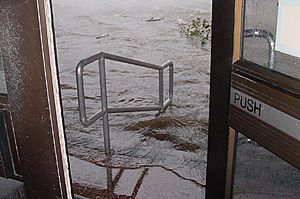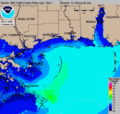Storm surge facts for kids
A storm surge is like a giant wall of water that rushes onto land near the coast. It's usually caused by powerful storms like hurricanes or other tropical cyclones. Imagine the storm pushing the ocean water ahead of it, making the water level rise much higher than normal.
This happens because strong winds from the storm push the water towards the shore. Also, the very low atmospheric pressure (the weight of the air) in the center of the storm acts like a giant vacuum, pulling the water level up. When these two things combine, a huge amount of water is pushed onto the land.
Storm surges can be very dangerous. They can flood coastal towns, destroy houses, and cause a lot of damage. They are often the most dangerous part of a hurricane.
What Causes a Storm Surge?
A storm surge forms mainly because of two things working together:
- Strong Winds: The powerful winds of a hurricane blow across the ocean's surface. This pushes the water forward, like a giant broom sweeping water towards the land.
- Low Pressure: The center of a hurricane has very low air pressure. This low pressure acts like a suction cup, lifting the ocean's surface slightly. When this lifted water is also pushed by strong winds, it creates an even bigger surge.
When the storm moves towards the coast, all this piled-up water has nowhere to go but onto the land, causing the surge.
How Dangerous Are Storm Surges?

Storm surges are extremely dangerous and can cause a lot of harm. Here's why:
- Flooding: The sudden rise in water can quickly flood homes, businesses, and roads, making it impossible to escape.
- Destruction: The force of the moving water can destroy buildings, bridges, and other structures. It can also carry away cars and debris.
- Erosion: Storm surges can wash away beaches and coastal land, changing the coastline.
- Loss of Life: Because they are so powerful and can happen quickly, storm surges can unfortunately lead to many deaths if people are not able to evacuate in time.
Scientists and weather experts use special tools and models to predict how high a storm surge might be. This helps people in coastal areas prepare and evacuate if needed.
Images for kids
-
Total destruction of the Bolivar Peninsula (Texas) by Hurricane Ike's storm surge in September 2008
-
Hurricane Ike storm surge damage in Gilchrist, Texas in 2008.
See also
 In Spanish: Marejada ciclónica para niños
In Spanish: Marejada ciclónica para niños





